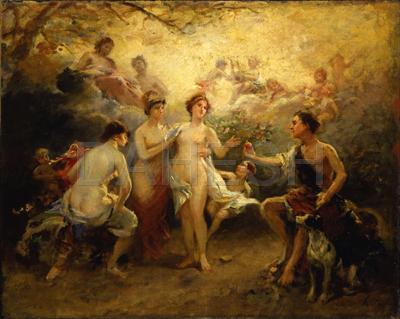Henry-Pierre Picou (French, 1824–1895)
The Judgment of Paris
Oil on canvas, 21 5/8 x 27 1/2 in.
Signed lower right: H. Picou
DM761

The story of the Judgment of Paris derives from Greek mythology, and in Homer’s Iliad it is cited as one of the primary factors leading to the Trojan War. When Eris, the goddess of discord, was left out of a banquet arranged by Zeus, she struck back by showing up at the celebration with a golden apple inscribed with words “for the fairest one.” Three goddesses laid claim to the item and the title: Hera, Athena, and Aphrodite. Rather than decide himself, Zeus asked Paris, a Trojan, to deliberate. Each goddess attempted to bribe Paris, but he ultimately awarded the golden apple to Aphrodite, goddess of love. In return, Aphrodite offered Paris the beautiful Helen, who was married to a Greek king. According to mythological sources, the Greeks’ attempts to retrieve Helen were the basis of the Trojan War.
The Judgment of Paris has been the subject of many paintings from the Renaissance onwards. Well-known examples by Peter Paul Rubens (ca.1636, National Gallery, London), Anton Raphael Mengs (ca.1757, Hermitage Museum, St. Petersburg), and a print by Marcantonio Raimondi after Raphael (ca.1515–1516) depict the three goddesses displaying themselves for the pensive Paris. In Picou’s version, the choice has been made and Paris is extending the golden apple to Aphrodite. The painting is created with sketchy brushstrokes, and a soft golden light emanating from the upper, heavenly portion suffuses the rest of the scene.


